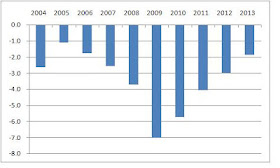The UK government
announced new public investment in the railways today – but not to start until
at least 2014! The IMF’s revised forecast for UK growth this year is 0.2%, with
only 1.4% in 2013. As Stephanie Flanders notes, the IMF seem somewhat
schizophrenic about what should be done about this – publishing reports
that clearly spell out how UK policy (monetary and fiscal) is too restrictive,
but at the same time apparently praising the current government’s stewardship. (Note
that the government sets the inflation target for monetary policy, so any move to raise this or
replace it with a nominal GDP target has to come from them.)
Chris
Dillow looks
at how countercyclical public investment has been in the past, and comes to the
perhaps surprising conclusion that it has been more countercyclical since 1980
than before. He therefore describes, with characteristic mischief, current
policy is a return to pre-Thatcherism. But his chart stops where the data
finishes, so I thought I’d focus on the recent past and add current government
plans, as seen by the Office for Budget Responsibility.
 |
|
We can
see how the previous government did the right thing in increasing public
investment as a share of GDP as the recession hit. It too was planning to
reduce public investment substantially in later years, but to be fair in 2009
you could argue that by 2012 the recession might have been over. But ignore the
politics – both the economics and the finance tell
you that now is the time to have a high share of public investment in GDP.
What history will say, about this and so much else, is that governments gave up
on stimulus much too soon. Below is the underlying (cyclically adjusted)
primary budget balance for the UK, as calculated by the OECD.
UK Underlying Primary Budget Balance, OECD Economic Outlook
Is the
best we can now hope for some additional spending in two years time? I refuse
to believe that it takes so long to organise any additional public investment. Towns
and villages across the country are currently suffering from flooding because
of inadequate flood defences, in part according to this report
because of flood defence projects that were ready to go but have not received
funding. But no, I’m being silly – such public investment would just crowd out
the private investment necessary to clean up the mess after the floods.
[1]
The published 2012/3 figure is only 1.2% of GDP, but looking at the small print
that seems to be an oddity to do with the Royal Mail’s pension fund. (Don’t ask
me to make sense of this.) Trying to adjust for this suggests a figure of 3%,
which is what is in the table above.
|

"I refuse to believe that it takes so long to organise any additional public investment"
ReplyDeleteOnly someone who has never experienced the EU public procurement regulations could write that way.
This comment has been removed by a blog administrator.
ReplyDelete